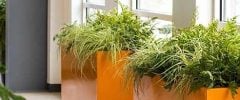How to Display and Maintain Air Plants in Interiorscapes

Air plants (Tillandsia) are a relatively rare sight in interiorscapes, mainly due to their small size, limited availability, and special care requirements. However, they possess a remarkable advantage over common tropical foliage—they thrive without soil. This distinctive trait opens up creative possibilities for mounted plant displays and vertical designs, allowing them to go where traditional plants simply can’t.
Unique Ways to Use Air Plants in Interiorscapes
Air plants bring a unique charm to interiorscape designs. Let’s take a closer look at how their versatility and visual appeal can transform ordinary plant arrangements into extraordinary works of art.
Creating Vertical Displays
When it comes to wall-mounted plant displays, you can’t go wrong with air plants. Their small root base can be gently tucked into a slit of a moss mat, and their lightweight structure often holds them in place without the need for wiring or glue. Whether you’re creating straight lines, gentle curves, or dramatic spirals, air plants offer endless possibilities for vertical arrangements.
Designing Natural Focal Points
Another creative way to feature air plants in interiorscape design is by mounting them to tree limbs in atriums or showcasing them on a focal piece of driftwood. Wiring is often the gentlest method to secure plants in place without causing damage. However, if gluing is a better fit for your particular display, choose a non-toxic adhesive like E6000, which is safe for plants. To keep the look natural, conceal any visible mechanics with Spanish or reindeer moss.
Incorporating Pops of Color
Unless they’re blooming, air plant foliage typically falls somewhere between gray-green and muted gray, but that doesn’t mean your display has to look dull. To liven things up, simply dip the air plant’s tips into a paint color of your choice. It’s a simple, creative way to bring a pop of color to mounted plants or wall displays.
How to Care for Air Plants Indoors
Air plants are experts at thriving outdoors, where they effortlessly absorb all the moisture and nutrients they need from the air. Indoors, however, it’s up to plant care technicians to recreate those vital conditions. With proper training and a clear understanding of how to care for air plants, they can thrive for a year or more in an interiorscape setting.
If your team has done well with orchids, you can expect a similar level of success. Like orchids, air plants are epiphytes, and they share many of the same care requirements, making them a natural fit for interiorscape professionals familiar with this plant family.
Watering for Optimal Health
Yes, air plants do need regular hydration. Proper watering is one of the most important aspects of Tillandsia care, and understanding how to water air plants correctly can make all the difference in their health and longevity. This can be done through misting or by giving them a quick soak, then placing them in a dry location to prevent rot. While they would benefit from more frequent moisture, a once-a-week watering routine is usually the most feasible option for plant care technicians.
Providing Ideal Light Conditions
Understanding air plant light requirements is essential for keeping them healthy indoors. Indirect or filtered natural light is best, but air plants can also adapt to continuous fluorescent lighting. Just be sure to shield them from direct sunlight, which can damage their delicate foliage.
Fertilizing for Longevity and Growth
While fertilizing is not essential, it can significantly boost an air plant’s lifespan, especially during the spring and summer when they are in their active growth cycle. If you can’t find a spray fertilizer formulated for air plants, a good alternative is to dilute liquid orchid fertilizer to half strength before applying. Use sparingly and avoid over-fertilizing, as this can damage the plant.
Maintaining Ideal Temperature and Humidity
As part of proper air plant care, maintaining a warm, stable environment is key. These plants prefer consistent temperatures and should be protected from exposure to cold drafts near vents or exterior doors. While they thrive in humid conditions, interiorscape settings—especially offices—can make it challenging to maintain high humidity. Still, air plants can adapt, especially when other needs like light and water are properly met throughout their growth cycle.
Understanding the Growth Cycle
While the pink or purple blooms of a flowering air plant may be beautiful, they actually signal the final stage in the plant’s life cycle. Once the flower fades away, the main plant begins to decline, eventually leaving behind small offshoots called pups. With the right care, these pups can continue the air plant growth cycle, giving your design new life and extending the plant’s overall life expectancy.
Final Thoughts on Working With Air Plants
Air plants are an ideal companion for creative interiorscape designs. With proper care, they can thrive on nearly any type of surface, giving you the freedom to experiment and let your imagination soar. No matter the design, air plants have a way of turning everyday interiors into memorable environments.
You May Also Like
Leave a Reply
You must be logged in to post a comment.




















